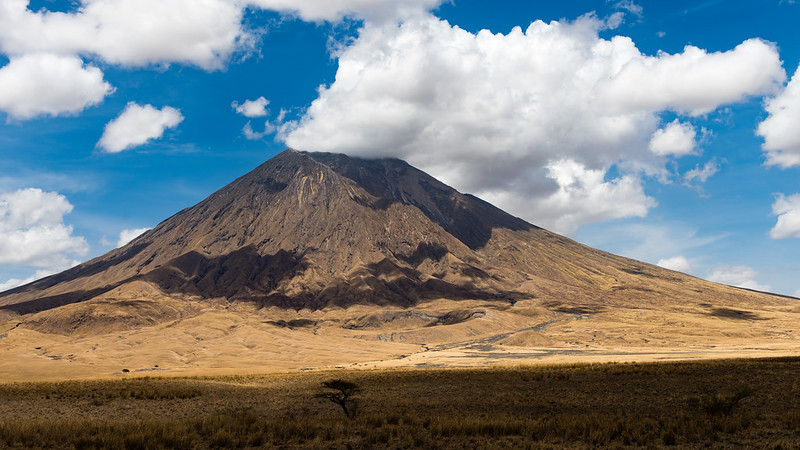Ol Doinyo Lengai Facts
- The term of Ol Doinyo Lengai serves as the most commonly used name for this true masterpiece of geological processes. But that term represents the english language translation of its name in the native tongue of the original inhabitants of its region.
- Two local groups of Indigenous Peoples share that common language. In the ancient tongue of the Maasai and the Sonjo, the term translates as The Mountain of God. They also use other terms, though, such as Basanjo, Donjo Ngai, and Mongogogura.
- Regardless of which moniker one uses, it’s an impressive natural feature. It also merits appreciation for its uniqueness. That’s due to the special attributes of the lava it produces. These easily rank it as one of the most unusual volcanoes on the planet.
- Due to its unique nature, the lava spewed forth by Ol Doinyo Lengai displays astonishing patterns. It’s initially black or brown in color. Within days, or sometimes only hours, however, it changes color. After that time, it changes to a snow-like white!
- Yet another quality of its flows distinguishes it from other volcanoes. Its flows are also highly liquid compared to others. In fact, these remain the most liquid-like of any known such flows. These also emerge at significantly lower temperatures than others.
Related Articles
Ol Doinyo Lengai Physical Description
The fabulous Ol Doinyo Lengai easily merits attention and appreciation by the viewer. It further does so for a variety of reasons. The site’s not the largest of its kind around the world, of course. Yet, its physical dimensions certainly qualify it as an impressive volcano.
The site boasts a remarkably rounded and even cone shape structure. The intriguing mountain also rises to a respectable height above the surrounding terrain. This aspect of the site makes it clearly visible over great distances. It stands an impressive 5,900 ft (1,800 m).
Each side of the summit of the mountain additionally features a large crater. These remain separated by a ridge measuring approximately 360 ft (110 m) in length. Despite such close proximity to each other, the two craters displays striking different appearances.
The one on the southern flank appears to be completely inactive. This sometimes fills with water. The other crater, however, presents a vastly different view. It’s routinely covered in fresh lava flows. It also regularly forms small, temporary cones that produce lava.
Ol Doinyo Lengai further manifests several parasitic vents. These smaller formations appear on its flanks. Presently, four of these exist on its slopes. The western flank also displays large, deep fractures. Large debris fields dot its sides as well, from earlier events.
It’s the lava itself that ranks as its most unique structure, however. This stratovolcano produces eruptions with an incredibly low silica content. Its composition consists of more than 50% carbonate, even though this compound rarely appears on the earth’s surface.
Ol Doinyo Lengai Location, Formation, and Importance
The location of Ol Doinyo Lengai probably won’t surprise many of you. That’s because this wonder of geological processes formed in a region of the world well known for its natural marvels. That’s due to the fact that it formed on what’s now the continent of Africa.
There, it lies in the rough southeastern section of the continent. That location places the amazing formation with the boundaries of the country of Tanzania. Within that area, the volcano lies in the more northerly portion of the country, above the Serengeti.
The mountain itself forms an integral part of the East African Rift Valley. Geological research indicates that this continental rift began forming around 1.2 million years ago. Over time, the resulting thinned crust allowed for the formation of the site as it’s seen today.
Though far too infinitesimally slow for human observation, this expansion continues today. Such ongoing movement generates the heat that still maintains the activity of the mountain. This continued movement by the rift proceeds at a leisurely 0.12 in (3mm) per year.
The mighty Ol Doinyo Lengai has much to offer. It plays a vital role in the overall health of the surrounding ecosystem. Its unique lava actually breaks down quickly when it rains. The resulting runoff has helped lead to the remarkable verdure of the entire region.
It’s importance doesn’t end there, though. That’s true since it’s also quite important to research. Carbonatite, which it produces, remains invaluable to the study of rare earth elements. This site represents the only actively producing source of these elements.
Features Sharing Its Range
Check out our other articles on 5 Remarkably Riveting Rays, Swamp Wallaby, Lake Superior, Dwarf Crested Iris, Blue Footed Booby, Giant Forest Ant, Fire Salamander, Jackson’s Chameleon

